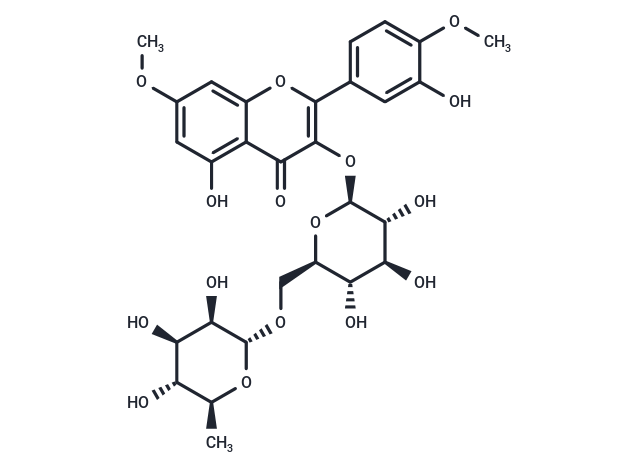Shopping Cart
- Remove All
 Your shopping cart is currently empty
Your shopping cart is currently empty

Ombuoside (Ombuin-3beta-rutinoside) has antifungal activity. Ombuoside shows significant antioxidant activity in the DPPH, and TEAC, reducing power assays.Ombuoside is a glycoside ombuoside isolated from Gynostemma pentaphyllum.

| Pack Size | Price | Availability | Quantity |
|---|---|---|---|
| 1 mg | $38 | In Stock | |
| 5 mg | $98 | In Stock | |
| 10 mg | $146 | In Stock | |
| 25 mg | Inquiry | In Stock | |
| 50 mg | Inquiry | In Stock | |
| 1 mL x 10 mM (in DMSO) | $113 | In Stock |
| Description | Ombuoside (Ombuin-3beta-rutinoside) has antifungal activity. Ombuoside shows significant antioxidant activity in the DPPH, and TEAC, reducing power assays.Ombuoside is a glycoside ombuoside isolated from Gynostemma pentaphyllum. |
| In vitro | Ombuoside and the synthetic derivatives octa-acetylOmbuoside, ombuine and retusine were tested for antimicrobial activity against several strains of Gram-positive and Gram-negative bacteria and the yeast Candida albicans, using the agar diffusion method. The flavonol glycoside Ombuoside and the respective aglycone ombuine, both exhibited moderated activity against Corynebacterium diphtheria, Staphylococcus aureus, Escherichia coli and Candida albicans. To a lesser degree, octaacetylOmbuoside and retusine showed activity against the Gram-positive bacteria C. diphtheria and S. aureus, but proved to be inactive against Gram-negative bacteria and Candida albicans[1] |
| Alias | Ombuin-3beta-rutinoside |
| Molecular Weight | 638.57 |
| Formula | C29H34O16 |
| Cas No. | 20188-85-6 |
| Smiles | COc1cc(O)c2c(c1)oc(-c1ccc(OC)c(O)c1)c(O[C@@H]1O[C@H](CO[C@@H]3O[C@@H](C)[C@H](O)[C@@H](O)[C@H]3O)[C@@H](O)[C@H](O)[C@H]1O)c2=O |
| Relative Density. | 1.66 g/cm3 (Predicted) |
| Storage | Powder: -20°C for 3 years | In solvent: -80°C for 1 year | Shipping with blue ice. | |||||||||||||||||||||||||||||||||||
| Solubility Information | DMSO: 65 mg/ml (101.79 mM) | |||||||||||||||||||||||||||||||||||
Solution Preparation Table | ||||||||||||||||||||||||||||||||||||
DMSO
| ||||||||||||||||||||||||||||||||||||

Copyright © 2015-2024 TargetMol Chemicals Inc. All Rights Reserved.